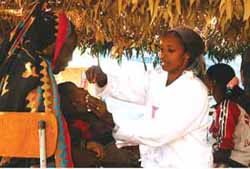3.3.5 Vitamin A supplements and measles prevention
It is important to know that in countries such as Ethiopia where vitamin A deficiency frequently occurs among children, vitamin A should be given routinely every six months. If a child has not previously received a vitamin A supplement, it should be given at the same time as the measles vaccine. This is because measles increases the risk of blindness due to vitamin A deficiency. Signs of vitamin A deficiency are white spots on the sclera (white part of the eye) and clouding of the cornea (the thin tissue covering the black centre of the eye and the coloured parts around it). In severe cases, blindness results.
Vitamin A is supplied in capsules of 100,000 IU (international units, which is the standard measurement for vitamin doses). Each capsule has a nipple at one end. The drops are given by cutting across the middle of the nipple with scissors and immediately squeezing the drops into the child’s mouth (Figure 3.3 on the next page). Vitamin A drops are also given in Child Health Days to ensure the dose is repeated every six months, until the child reaches five years.

The routine dose of vitamin A for a child aged 6–11 months is the drops from one capsule (100,000 IU); the drops from two capsules (200,000 IU) are given to children aged 12–59 months at regular intervals, every six months. This ensures that all children are fully protected from the harmful effects of vitamin A deficiency.
Vitamin A for children with measles
What should you do if you see a child who has already developed measles? Do not give vitamin A drops if the child has received a dose within the last month. But if a child with measles has not recently received a vitamin A supplement, give the vitamin A treatment dosages summarised in Table 3.4. The second dose should be given 24 hours after the first dose.
| Age | Immediately on diagnosis | After 24 hours | Follow-up |
|---|---|---|---|
| Infants less than 6 months old | 50,000 IU | 50,000 IU | Third dose given two to four weeks later if there are still signs of vitamin A deficiency |
| Infants aged 6–11 months | 100,000 IU | 100,000 IU | |
| Children aged 12 months and over | 200,000 IU | 200,000 IU |
3.3.4 Contraindications for measles vaccine, adverse events and how to manage them
